Rapid urbanisation, severe climate change, increased customer demands, and emerging digital technologies will all affect the water industry in the future years. Businesses will face a complicated set of issues as a result of these changes, which may be worth addressing in order to stay competitive in the sector.
Our water business faces a number of difficulties, including population expansion in metropolitan areas, climate change, water supply risk, and ageing infrastructure. In the face of rising demand, the business must also evaluate, how it will address energy costs, emergency response actions, environmental risk, regulatory change, infrastructure security, and community relations.
Improving the maintenance of water and wastewater infrastructure, as well as the reliability of monitoring and control systems, is critical to tackling these issues, providing a stable and reliable water supply in the future will necessitate new technologies and systems capable of real-time monitoring of water resources. The Internet of Things (IoT), which refers to the growing number of internet-connected items in our society, lies at the heart of this new capability.
Is it possible to turn such obstacles into opportunities for enterprises, customers, and the environment?
Yes, we believe so.
What are the Factor Impact on Water Industry in Future
We've identified five major things that are likely to have an influence on the water industry during the next years.
1-Obsolete infrastructure and asset maintenance:In order to be operational, utilities must replace aged equipment and software systems on a regular basis. Control and monitoring systems, which provide vital alarms, operator control of processes and water assets, as well as data collecting and historian capability, are not exempt.The availability and uptime of certain systems and equipment decreases as they age, and more maintenance may be required. This wastes significant resources on planned and unforeseen downtime, as well as chores such as driving out to maintenance sites.
2-Keeping expenditures under control in the face of escalating electricity prices:In recent years, wholesale power rates have risen by 150 percent to 240 percent, which has had an impact on how business is invoiced. Manufacturing, mining, and utilities use more than half of all power consumed by businesses [57 percent]. Because water pumping is such an energy-intensive process, the water industry is particularly vulnerable to fluctuations in energy prices.
3-Urban population growth, as well as rural services, are both on the rise:The first and most visible difficulty of urbanisation is ensuring adequate supplies. The second concern is maintaining water quality and the accompanying environmental risk posed by urban development.Meanwhile,due to depopulation, asset dispersion, and resourcing requirements, services in rural and isolated areas remain expensive. In effect, the industry must accomplish more with less resources.
4-Environment and long-term viability:The water sector faces a number of environmental concerns, including urbanisation, sewer leakage risks, flooding, sustainable energy supply, and climate change.Increased population and urban sprawl, as previously mentioned, can raise the risk of storm water runoff contamination if not properly controlled.
5-An ageing workforce and a skills shortage:The technological advancements will raise the demand for specialised skills in the workforce, such as data analysis and data literacy, network security, and higher-order skills such as creativity, critical thinking, problem-solving, and inter-personal communication.




